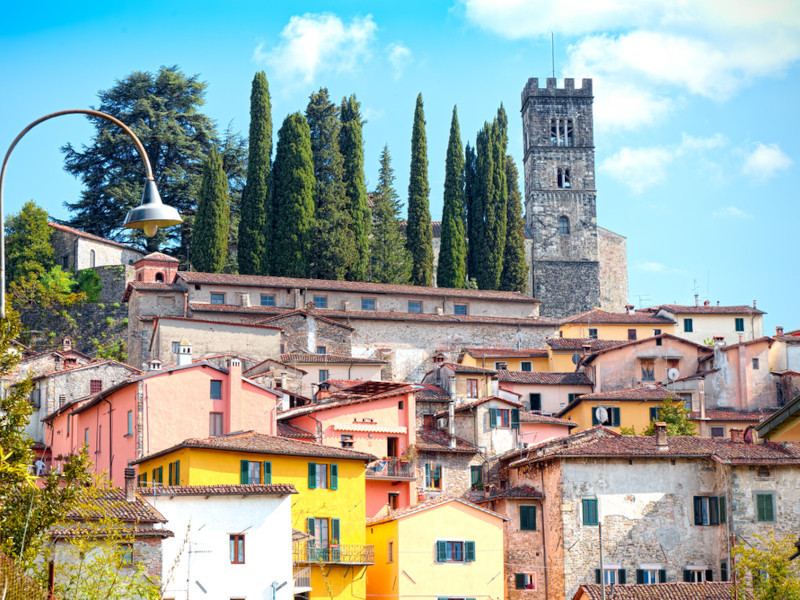Barga
Barga is a medieval town and comune of the province of Lucca in Tuscany, central Italy. It is home to around 10,000 people and is the chief town of the "Media Valle" (mid valley) of the Serchio River. Geography Barga lies 35 kilometres (22 mi) north of the provincial capital, Lucca. It is overlooked by the village of Albiano, a località of Barga, which in the 10th century was the site of a castle protecting the town. Pania della Croce, a mountain of the Apuan Alps, dominates the surrounding chestnut trees, grape vines and olive groves. History In the 9th century, Barga is mentioned as a family feud of the Lombard family of Rolandinghi. In the 11th century, Barga obtained from Matilda of Tuscany broad privileges including tax exemptions. However, formally Barga was still subordinate to Lucca. When Matilda died, she left all her properties, including the Serchio Valley, to the Church, which was not really a popular decision, and caused a war. Despite the war, Barga was not looted, apparently, because of the presence of the nuncius, sent to the valley by the Pope Gregory IX. As the result of the war, the diocese of Lucca was abolished and split between several parties, including Pisa. Barga took advantage of it, and in the 13th century helped Pisa against Lucca, but in 1236 was finally subordinated to Lucca. After these events, Barga has developed as an important trade city which had connections with Modena over mountain roads. The city grew as a castle surrounded by a line of walls, of which two gates (Porta Reale and Porta Macchiaia) have survived. The town was well known during the Middle Ages for the manufacture of silk threads which were exported to major centres such as Florence, its mills powered by the hydraulic power of the nearby creeks. In the Middle Ages, Lucca and Pisa battled frequently to conquer the wealthy town and the surrounding territory, and for a time Barga was part of the Florentine dominion, later Duchy and Grand Duchy of Tuscany. Between 1331 and 1859 Albiano owed its allegiance to the Florentine State. It became part of the Kingdom of Italy in 1861. Since 1923 Barga is part of the province of Lucca. The region was part of the Gothic Line in World War II, and was the scene of fierce fighting between the Allies and Germans from October 1944 until April 1945. Main sights Main sights include: Duomo (cathedral) (11th-16th centuries), the main example of Romanesque architecture in the Serchio Valley. Of the original church, built in local limestone, parts of the façade remain. The interior has a nave and two aisles. It houses a large (3.5 m) wooden statue of St. Christopher, patron of the city. The pulpit (12th century) was designed by Guido Bigarelli da Como, with four red marble columns resting on lion sculptures. The campanile contains three bells, the oldest of which dates to the 16th century. Arringo, a large lawn between the Duomo and the Palazzo Pretorio Loggia del Podestà (14th century). Church of San Francesco, with several works by Andrea della Robbia Culture There is an annual international opera festival, called "Opera Barga Festival", and a long running and very successful jazz festival, "Bargajazz". Recently, Barga has become the home of many painters, including John Bellany who exhibit their work in some of the small galleries within the castle walls. The "Sagra" is a feature of Italian rural culture; communal meals for several hundred people, eaten in the open air, often in orchards, vineyards or sports grounds. Originally religious celebrations, they are now often used to raise funds for local causes. Each town and village will have its own peculiar sagra: Around Barga from July to September it is possible to participate in a Sagra every night. In Barga itself there is the "Cena in Vignola" in the vineyard below the Duomo, and in August the "Sagra del pesce e Patate" (Fish and Chips) in celebration of the Barga/Scottish connection. At nearby San Pietro in Campo, there is the "Sagra del Maiale" (Pork), at Filecchio the "Sagra della Polenta e Ucelli" (originally small wild birds, now pheasant), at Fornaci di Barga the "1°Maggio expo". The Italian Touring Club has recently assigned the "orange flag" of the "Migliori borghi d'Italia" ("Best Villages of Italy"), a distinguished sign recognizing the peculiarity of its beauty and of its quality. Barga has also been, since 1999, the home of the "European Gnome Sanctuary" run by the Garden Gnome Liberation Front. The frazione of Castelvecchio Pascoli was home to one of Italy's 19th century poet Giovanni Pascoli. In 2008 Barga became the first medieval historic centre in Italy to be mapped and equipped with QR codes (2D barcodes) for all of the churches, palazzo's statues, restaurants, bars and places of interest. After a two-year trial, the project was released to the public in Dec 2010 under the name iBarga. Visitors can now get precise up to date information about the city on their mobile telephones and in 10 different languages Sport In 1991 the local sport center named "Il Ciocco" hosted the second edition of UCI Mountain Bike & Trials World Championships. Sister cities Hayange, France Gällivare, Sweden Prestonpans, Scotland Cockenzie, Scotland Port Seton, Scotland Longniddry, Scotland[1] Notable natives and residents Antonio Nardini, historian Lorenzo Baldisseri, archbishop Nadia Centoni, volleyball player Gualtiero Jacopetti, film director Paolo Nutini, singer Rachel Sermanni, musician Johnny Moscardini, football player John Bellany, painter Frank Viviano, journalist and author References External links Official website (Italian) Origins of Sommocolonia-Barga (Interview of the historian Antonio Nardini) BBC News item on Barga "Close-up: 'The most Scottish place in Italy'

